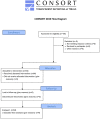Heart rate dynamics during cardio-pulmonary exercise testing are associated with glycemic control in individuals with type 1 diabetes
- PMID: 29608593
- PMCID: PMC5880363
- DOI: 10.1371/journal.pone.0194750
Heart rate dynamics during cardio-pulmonary exercise testing are associated with glycemic control in individuals with type 1 diabetes
Abstract
Introduction: This study investigated the degree and direction (kHR) of the heart rate to performance curve (HRPC) during cardio-pulmonary exercise (CPX) testing and explored the relationship with diabetes markers, anthropometry and exercise physiological markers in type 1 diabetes (T1DM).
Material and methods: Sixty-four people with T1DM (13 females; age: 34 ± 8 years; HbA1c: 7.8 ± 1% (62 ± 13 mmol.mol-1) performed a CPX test until maximum exhaustion. kHR was calculated by a second-degree polynomial representation between post-warm up and maximum power output. Adjusted stepwise linear regression analysis was performed to investigate kHR and its associations. Receiver operating characteristic (ROC) curve was performed based on kHR for groups kHR < 0.20 vs. > 0.20 in relation to HbA1c.
Results: We found significant relationships between kHR and HbA1c (β = -0.70, P < 0.0001), age (β = -0.23, P = 0.03) and duration of diabetes (β = 0.20, P = 0.04). Stepwise linear regression resulted in an overall adjusted R2 of 0.57 (R = 0.79, P < 0.0001). Our data revealed also significant associations between kHR and percentage of heart rate at heart rate turn point from maximum heart rate (β = 0.43, P < 0.0001) and maximum power output relativized to bodyweight (β = 0.44, P = 0.001) (overall adjusted R2 of 0.44 (R = 0.53, P < 0.0001)). ROC curve analysis based on kHR resulted in a HbA1c threshold of 7.9% (62 mmol.mol-1).
Conclusion: Our data demonstrate atypical HRPC during CPX testing that were mainly related to glycemic control in people with T1DM.
Conflict of interest statement
Figures





References
-
- Balady GJ, Arena R, Sietsema K, Myers J, Coke L, Fletcher GF, et al. Clinician’s Guide to Cardiopulmonary Exercise Testing in Adults: A Scientific Statement From the American Heart Association. Circulation. 2010;122: 191–225. doi: 10.1161/CIR.0b013e3181e52e69 - DOI - PubMed
-
- Hofmann P, Tschakert G. Special Needs to Prescribe Exercise Intensity for Scientific Studies. Cardiol Res Pract. 2011;2011: 1–10. doi: 10.4061/2011/209302 - DOI - PMC - PubMed
-
- Moser O, Tschakert G, Mueller A, Groeschl W, Hofmann P, Pieber T, et al. Short-acting insulin reduction strategies for continuous cycle ergometer exercises in patients with type 1 diabetes mellitus. Asian J Sports Med. 2017;8 doi: 10.5812/asjsm.42160 - DOI
-
- Conconi F, Ferrari M, Ziglio PG, Droghetti P, Codeca L. Determination of the anaerobic threshold by a noninvasive field test in runners. J Appl Physiol. 1982;52: 869–73. doi: 10.1152/jappl.1982.52.4.869 - DOI - PubMed
-
- Ribeiro JP, Fielding RA, Hughes V, Black A, Bochese MA, Knuttgen HG. Heart rate break point may coincide with the anaerobic and not the aerobic threshold. Int J Sports Med. 1985;6: 220–4. doi: 10.1055/s-2008-1025844 - DOI - PubMed
Publication types
MeSH terms
Substances
LinkOut - more resources
Full Text Sources
Other Literature Sources
Medical

